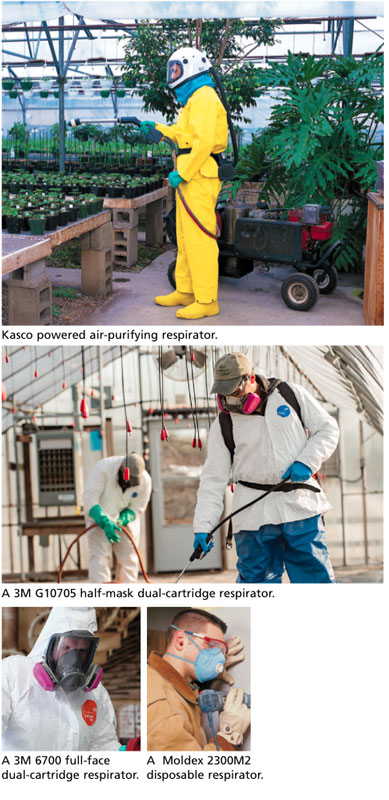4/1/2022
Revisiting Respiratory Safety
Jennifer Zurko

A lot of us may be all masked out after two-plus years of a global pandemic, but for those who wear masks during their daily lives—like doctors and dentists, or those working with dusty or dangerous products around the greenhouse—wearing the proper mask could be a matter of life or death.
Gemplers Farm & Home Supply reminded us of the importance of respiratory safety for your greenhouse workers and how to choose the right personal protective equipment (PPE) to ensure their health isn’t compromised.
First, there are three key steps to choosing the right respirator when working with respiratory hazards like dust, mold, pesticides and more.
1. Know your hazard. From what do you need protection? Common hazards like dust, mold, paint and pesticides have unique PPE requirements. Paying attention to material labels is the first key to staying safe. Labels often include respiratory protection recommendations to help keep you safe.
2. Pick your protection. Respiratory protection products come in different types. The right one for you and your staff depends upon the hazard, whether you’ll do this job often or once in a while, and what respirator equipment you already have.
3. Choose your respirator. Pick disposable, reusable or powered respirator equipment that’s compatible with the specific filter, cartridge or combination you need to stay safe on the job. Pay attention to brand and fit compatibility, and don’t forget to fit-test your respirator.
Do I need a filter, cartridge or both for my respirator?
The answer depends on the hazard from which you need protection.
• Particulate filters: Filters only particles (e.g., dust, mists, fumes, smoke, mold, bacteria, etc.). Some filters also have nuisance-level, non-hazardous gas and vapor absorption capabilities.
• Gas & vapor cartridges: Filters only gases and vapors. There are different kinds of cartridges for different kinds of gases and vapors.
• Combination cartridge/filters: Filters particles, gases and vapors. Different combination particulate/cartridge filters are used depending on the gas or vapor present in the air. You also may hear the combination referred to as using a cartridge with a particulate “pre-filter.”
Knowing and choosing your respirator
Choosing the right type of respirator is crucial to the health and safety of you and your crew on the job. The right respirator can be the difference between safe and sorry when performing tasks that put you in contact with dust, mold, paint, pesticides or a combination.
• Filtering facepiece respirators (FFR, also known as particulate or disposable respirators)—These types of respirators are used to protect the wearer from dust, pollen and mists, as well as some welding fumes and pesticides. They’re disposable, intended to be worn for only one work shift at the most. The facepiece itself is made of the filter material and has two elastic straps. With the proper fit, filtering facepiece respirators provide sufficient protection against some particulate hazards. However, it can be more challenging to achieve a snug, safe, leak-proof fit with these disposable respirators versus other types of respirators.
• Half-mask dual-cartridge respirators—The main advantage of dual-cartridge types of respirators is the higher level of protection compared to FFRs. They have reusable facepieces made of a flexible elastomer that can form a tighter seal to your face, and replaceable cartridges and/or filters that can be changed to filter out different gas and vapor contaminants, as well as particulates. Half-mask dual-cartridge respirators cover your mouth and nose, and are commonly used for protection against pesticides, acid gases, dust or welding fumes. Because they only cover half of your face, they provide no protection from eye irritants and less coverage for skin irritants than a full-face respirator.
• Full-face dual-cartridge respirators—A full-face, dual-cartridge, reusable respirator offers more protection than a half-mask by covering your eyes and more of your face, in addition to the nose and mouth area. When working with contaminants that can irritate the face, eyes or skin, a full-face, dual-cartridge respirator will offer better protection than a half-mask worn with goggles.
• Powered air-purifying respirators (PAPR)—These offer comfortable breathing from a battery-powered fan, which pulls air through the cartridges and/or filters, and circulates the clean air to the facepiece, helmet or hood. PAPRs with loose-fitting helmets or hoods are a good option for respiratory protection when facial hair would otherwise prevent a proper seal with a tight-fitting dual cartridge respirator. They also can be more comfortable for the user than other types of respirators, but they’re also more expensive. GT